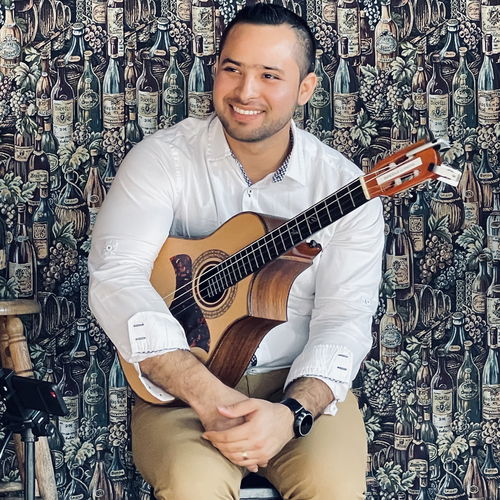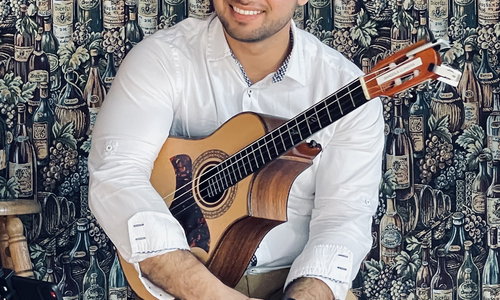“Rhythms of South America”
Details
Alejo Cordero full profile / Bandola llanera and loop station / 1 musician
Full program notes
“Rhythms of South America: A Journey Through Four Strings“
Immerse yourself in the vibrant sounds of South America as the strings of the bandola llanera bring to life iconic genres from across the continent. This program journeys through the energetic joropo of Colombia and Venezuela, the passionate tango of Argentina, the festive porro of Colombia’s Caribbean coast, and the rhythmic pulse of cumbia. Each piece weaves together rich cultural traditions, offering a dynamic and soulful exploration of South America’s diverse musical heritage.
1. Joropo Llanero (Traditional, Colombia/Venezuela)
The joropo is a lively and energetic genre, deeply rooted in the plains of Colombia and Venezuela. This fast-paced music is characterized by its syncopated rhythms and virtuosic improvisation, making it both challenging and exhilarating to perform. For me, the joropo represents a direct connection to my roots, and playing it on the bandola llanera allows me to express both the technical and emotional depth of this tradition.
2. Tango (Argentina)
Tango is perhaps Argentina’s most iconic musical genre, known for its passion, drama, and intricate dance forms. Its deep emotions are conveyed through melancholic melodies and strong, rhythmic undercurrents. I chose this piece because of its intensity and its ability to evoke a wide range of feelings—from longing and desire to joy and melancholy. The bandola’s voice adds a unique interpretation to this genre, bringing out new textures in its famous melodies.
3. Porro (Traditional, Colombia)
The porro is a vibrant and upbeat genre from Colombia’s Caribbean coast, often associated with brass bands and festive celebrations. In its instrumental form, the porro captures the energy and joy of the Colombian people. I selected this piece because of its lively nature, and I enjoy how its rhythmic complexity blends with the warmth of the bandola, creating a spirited and celebratory atmosphere.
4. Cumbia (Traditional, Colombia)
Cumbia is one of Colombia’s most recognized musical exports, with its infectious rhythms and characteristic blend of indigenous, African, and Spanish influences. This piece resonates deeply with me, as it embodies the heartbeat of Colombian culture—joyful, communal, and rhythmically complex. Playing cumbia on the bandola brings a fresh interpretation to the genre, giving a new voice to its timeless melodies and captivating beats.
Historical context
The music you’ll hear tonight draws from some of the most important musical traditions of South America, each of which has played a crucial role in shaping the cultural identity of the region.
The joropo comes from the plains of Colombia and Venezuela, with its roots in the 18th century, blending indigenous, Spanish, and African influences. It developed as a dance and musical form in rural communities and became a symbol of national pride, especially in Venezuela.
Tango, originating from the streets of Buenos Aires in the late 19th century, arose from the fusion of European immigrants’ music and African rhythms. It evolved from humble beginnings in the working-class neighborhoods into a globally renowned genre, symbolizing both the passion and melancholy of Argentina’s cultural life.
The porro is a festive rhythm that hails from Colombia’s Caribbean coast. Its history is tied to the indigenous and African communities who used it to celebrate communal events. Over time, it became part of Colombia’s national musical identity, especially through brass bands that played during local festivals.
Finally, cumbia is one of Colombia’s most iconic genres, believed to have originated as a courtship dance among enslaved Africans. Over centuries, it blended with indigenous and Spanish elements, becoming a symbol of Colombian identity and spreading its infectious rhythms throughout Latin America.
Each of these traditions carries a deep cultural resonance, as they have been passed down through generations, holding communities together with their powerful rhythms and emotive melodies. By playing these pieces on the bandola llanera, I aim to continue the lineage of South American music, bringing its rich history to life through contemporary interpretation.
Videos from this player
Audio from this player
Adaptation of a classical guitar piece
Other programs from this ensemble
Classical and South American sounds
- Musician profile: Alejo Cordero
-
Instruments: Solo Bandola Llanera

 Continue with Facebook
Continue with Facebook
 Continue with Google
Continue with Google
 Continue with Apple
Continue with Apple
